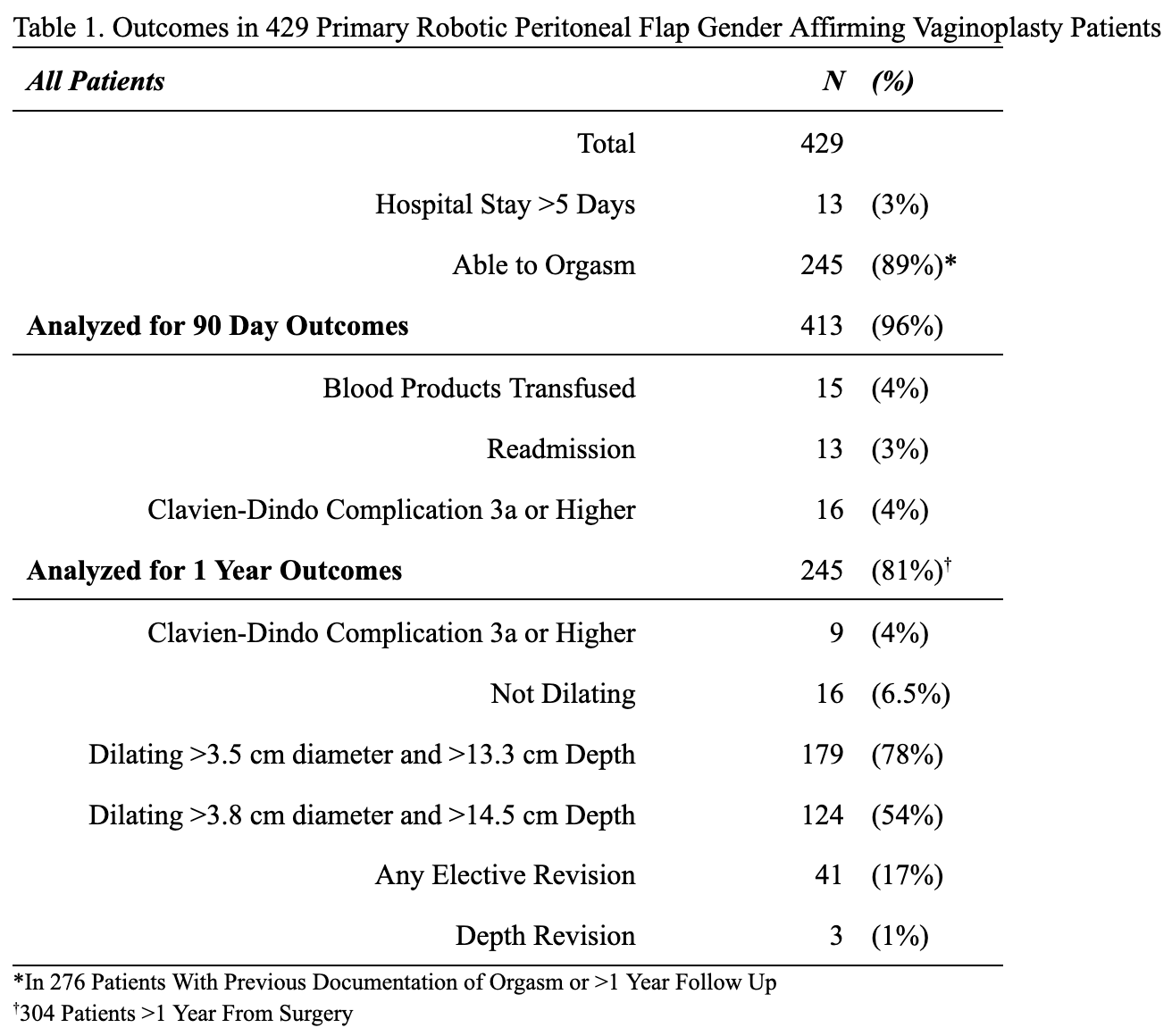Back
Introduction: Gender affirming robotic peritoneal flap vaginoplasty is a promising adaptation of established vaginoplasty techniques that has been performed since 2017. We report perioperative factors and patient reported outcomes for all consecutive cases at one center.
Methods: Records of patients undergoing primary robotic peritoneal flap gender affirming vaginoplasty with the senior authors from 9/2017-8/2022 were retrospectively reviewed. Operative time, length of stay, complications, self-report of orgasm and dilation, and date of last follow up were recorded for all patients. Clavien-Dindo grading for severity of complications were organized according to occurrence prior or after 90 days postoperatively. For outcomes with incidence greater than 5%, statistical analysis for change over years was performed using nonparametric tests.
Results: Primary robotic peritoneal flap gender affirming vaginoplasty was performed on 429 patients with median follow up of 369 days (interquartile range 186-607). Of these, 413 patients (96%) had 90 day or longer follow up and 16 (4%) had a Clavien-Dindo 3a or 3b complication within that period [Table 1]. 245 patients had a follow up of 1 year or greater, and 9 patients (4%) had Clavien-Dindo 3a or 3b complications after 90 days in this cohort. Overall elective revision rate was 17%, with 1% revision for vaginal depth. Significant decrease in operative time was observed (p <.0001), with a mean operative time of 101 mins for cases 400-429 . Rate of dilating using the largest dilator to the deepest dot increased over these first 300 cases (p <.001) and rate of elective revision decreased (p <.001).
Conclusions: Primary robotic peritoneal flap gender affirming vaginoplasty has low morbidity and complication rates with durable vaginal depth and orgasmic function at long term follow up. SOURCE OF
Funding: none

Podium Session
Session: PD12: Trauma/Reconstruction/Diversion: External Genitalia & Urotrauma (including Transgender Surgery) II
PD12-09: Outcomes of 429 Primary Robotic Peritoneal Flap Gender Affirming Vaginoplasty Cases
Saturday, April 29, 2023
8:20 AM – 8:30 AM CST
Location: S401C

Gaines Blasdel (he/him/his)
Research Associate
New York University Langone Health, University of Michigan Medical School
Podium Presenter(s)
Introduction: Gender affirming robotic peritoneal flap vaginoplasty is a promising adaptation of established vaginoplasty techniques that has been performed since 2017. We report perioperative factors and patient reported outcomes for all consecutive cases at one center.
Methods: Records of patients undergoing primary robotic peritoneal flap gender affirming vaginoplasty with the senior authors from 9/2017-8/2022 were retrospectively reviewed. Operative time, length of stay, complications, self-report of orgasm and dilation, and date of last follow up were recorded for all patients. Clavien-Dindo grading for severity of complications were organized according to occurrence prior or after 90 days postoperatively. For outcomes with incidence greater than 5%, statistical analysis for change over years was performed using nonparametric tests.
Results: Primary robotic peritoneal flap gender affirming vaginoplasty was performed on 429 patients with median follow up of 369 days (interquartile range 186-607). Of these, 413 patients (96%) had 90 day or longer follow up and 16 (4%) had a Clavien-Dindo 3a or 3b complication within that period [Table 1]. 245 patients had a follow up of 1 year or greater, and 9 patients (4%) had Clavien-Dindo 3a or 3b complications after 90 days in this cohort. Overall elective revision rate was 17%, with 1% revision for vaginal depth. Significant decrease in operative time was observed (p <.0001), with a mean operative time of 101 mins for cases 400-429 . Rate of dilating using the largest dilator to the deepest dot increased over these first 300 cases (p <.001) and rate of elective revision decreased (p <.001).
Conclusions: Primary robotic peritoneal flap gender affirming vaginoplasty has low morbidity and complication rates with durable vaginal depth and orgasmic function at long term follow up. SOURCE OF
Funding: none

